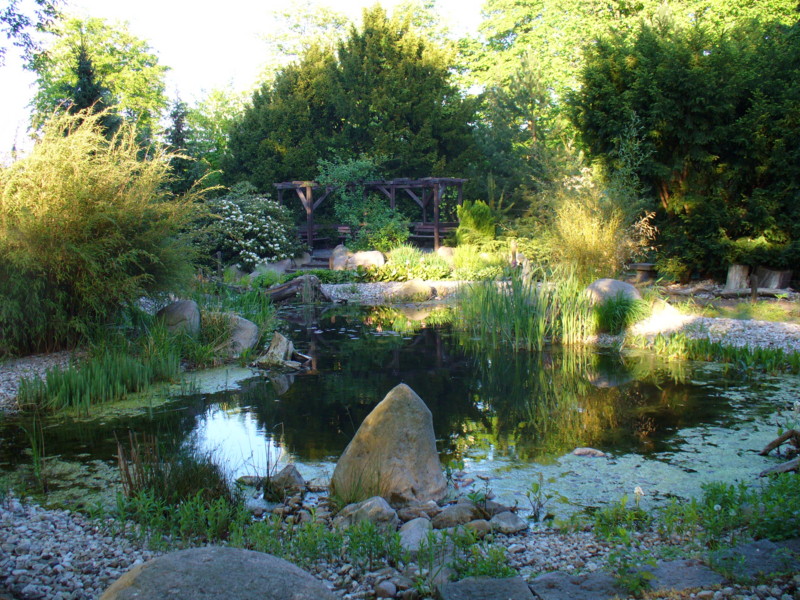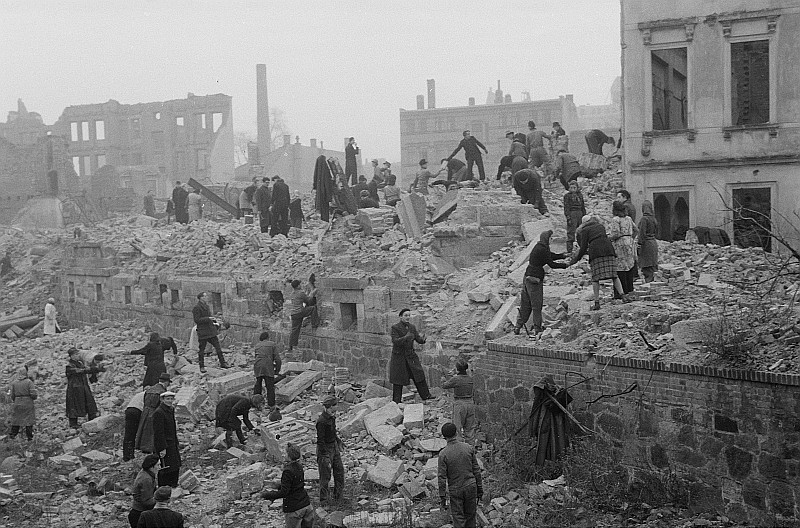|
Nordfriedhof (Leipzig)
The Nordfriedhof ("North Cemetery") is a public cemetery run by the city of Leipzig, located at Berliner Straße 125–127 in the district of Eutritzsch between Hamburger Straße, Theresienstraße and Maximilianallee, directly adjoining the smaller Old Jewish Burial Ground ("Alter Israelitischer Friedhof"). History The Nordfriedhof was opened on 24 May 1881. In comparison to the largest burial ground in the city, the Südfriedhof, which covers 82 hectares, the Nordfriedhof has less than a tenth of the area, at 7.3 hectares. Nevertheless in terms of landscaping, ecology and tree-planting it is extremely varied, and has, for example, an area of wetland, set up after the year 2000. The cemetery buildings date from the years 1905–1910. Otto Brückwald constructed a complex based on Italian models with leafy wooden arcades connecting the chapel, the mortuary and the administrative buildings. The chapel was destroyed during the air raids of 4 December 1943. To the left ... [...More Info...] [...Related Items...] OR: [Wikipedia] [Google] [Baidu] |
Nordfriedhof Leipzig, Biotop
Nordfriedhof is the German for "North(ern) Cemetery" or "North(ern) Burial Ground" and may refer to the following: * Nordfriedhof (Cologne) * Nordfriedhof (Dresden) * Nordfriedhof (Leipzig) * Nordfriedhof (Munich) ** Nordfriedhof (Munich U-Bahn) Nordfriedhof is an U-Bahn station in Munich Munich ( ; german: München ; bar, Minga ) is the capital and most populous city of the States of Germany, German state of Bavaria. With a population of 1,558,395 inhabitants as of 31 July ... station is named from the cemetery * Alter Nordfriedhof (Munich) {{geodis ... [...More Info...] [...Related Items...] OR: [Wikipedia] [Google] [Baidu] |
Carl Christian Philipp Tauchnitz
Tauchnitz was the name of a family of German printers and publishers. They published English language literature for distribution on the European continent outside Great Britain, including initial serial publications of novels by Charles Dickens. Though copyright protection did not exist between nations in the 19th century, Tauchnitz paid the authors for the works they published, and agreed to limit their sales of English-language books to the European continent, as authors like Dickens or Bulwer-Lytton had separate arrangements for publication and sale in Great Britain. Carl Christoph Traugott Tauchnitz Carl Christoph Traugott Tauchnitz (1761–1836), born at Grossbardau near Grimma, Saxony, established a printing business in Leipzig in 1796 and a publishing house in 1798. He specialized in the publication of dictionaries, Bibles, and stereotyped editions of the Greek and Roman classics. He was the first publisher to introduce stereotyping into Germany. The business was carri ... [...More Info...] [...Related Items...] OR: [Wikipedia] [Google] [Baidu] |
Cemeteries In Leipzig
A cemetery, burial ground, gravesite or graveyard is a place where the remains of dead people are buried or otherwise interred. The word ''cemetery'' (from Greek , "sleeping place") implies that the land is specifically designated as a burial ground and originally applied to the Roman catacombs. The term ''graveyard'' is often used interchangeably with cemetery, but a graveyard primarily refers to a burial ground within a churchyard. The intact or cremated remains of people may be interred in a grave, commonly referred to as burial, or in a tomb, an "above-ground grave" (resembling a sarcophagus), a mausoleum, columbarium, niche, or other edifice. In Western cultures, funeral ceremonies are often observed in cemeteries. These ceremonies or rites of passage differ according to cultural practices and religious beliefs. Modern cemeteries often include crematoria, and some grounds previously used for both, continue as crematoria as a principal use long after the interment a ... [...More Info...] [...Related Items...] OR: [Wikipedia] [Google] [Baidu] |
Battle Of Leipzig
The Battle of Leipzig (french: Bataille de Leipsick; german: Völkerschlacht bei Leipzig, ); sv, Slaget vid Leipzig), also known as the Battle of the Nations (french: Bataille des Nations; russian: Битва народов, translit=Bitva narodov), was fought from 16 to 19 October 1813 at Leipzig, Saxony. The Coalition armies of Austria, Prussia, Sweden, and Russia, led by Tsar Alexander I and Karl von Schwarzenberg, decisively defeated the '' Grande Armée'' of French Emperor Napoleon Bonaparte. Napoleon's army also contained Polish and Italian troops, as well as Germans from the Confederation of the Rhine (mainly Saxony and Württemberg). The battle was the culmination of the German Campaign of 1813 and involved 560,000 soldiers, 2,200 artillery pieces, the expenditure of 400,000 rounds of artillery ammunition, and 133,000 casualties, making it the largest battle in Europe prior to World War I. Decisively defeated again, Napoleon was compelled to return to France while ... [...More Info...] [...Related Items...] OR: [Wikipedia] [Google] [Baidu] |
Leipzig Zoo
Leipzig Zoological Garden, or Leipzig Zoo (german: link=no, Zoologischer Garten Leipzig) is a zoo in Leipzig`s district Mitte, Germany. It was first opened on June 9, 1878. It was taken over by the city of Leipzig in 1920 after World War I and now covers about and contains approximately 850 species. By 2020 the zoo featured six different theme worlds, aiming at providing habitats appropriate for the species on display. Leipzig zoo is internationally noted for its large building projects such as Pongoland (housing gorillas, chimpanzees, bonobos and orangutans) and Gondwanaland (world's second largest indoor rainforest hall at ). It has bred more than 2,000 lions, 250 rare Siberian tigers, and other carnivores like bears. Leipzig Zoological Garden has been called the "Zoo of the future". It is ranked as the best zoo in Germany and also the second-best in Europe (after Vienna). Family visit Family friendly extras include a large number of playgrounds, picnic areas, various gastron ... [...More Info...] [...Related Items...] OR: [Wikipedia] [Google] [Baidu] |
Arthur Kollmann
Arthur Kollmann (1858–1941) "Felix Martin Oberländers Beiträge zur Urologie" (PDF file), ''SpringerLink'', part of ''Springer Science+Business Media'', 2006, webpage: Springer-PDF was a German medical researcher from Hamburg who studied the fingerprint characteristics of friction ridges and volar pads. "Michele Triplett's Fingerprint Dictionary: K" (glossary), Michele Triplett, 2006, ''Fprints.nwlean.net'' webpage: Fprints-K. In the 1880s (1883, 1885), Kollmann was the first researcher to address the formation of friction ridges on the fetus A fetus or foetus (; plural fetuses, feti, foetuses, or foeti) is the unborn offspring that develops from an animal embryo. Following embryonic development the fetal stage of development takes place. In human prenatal development, fetal dev ... and the random physical stresses and tensions which may have played a part in their growth. Kollmann may have been the first researcher to study the development of ... [...More Info...] [...Related Items...] OR: [Wikipedia] [Google] [Baidu] |
Urologist
Urology (from Greek οὖρον ''ouron'' "urine" and ''-logia'' "study of"), also known as genitourinary surgery, is the branch of medicine that focuses on surgical and medical diseases of the urinary-tract system and the reproductive organs. Organs under the domain of urology include the kidneys, adrenal glands, ureters, urinary bladder, urethra, and the male reproductive organs (testes, epididymis, vas deferens, seminal vesicles, prostate, and penis). The urinary and reproductive tracts are closely linked, and disorders of one often affect the other. Thus a major spectrum of the conditions managed in urology exists under the domain of genitourinary disorders. Urology combines the management of medical (i.e., non-surgical) conditions, such as urinary-tract infections and benign prostatic hyperplasia, with the management of surgical conditions such as bladder or prostate cancer, kidney stones, congenital abnormalities, traumatic injury, and stress incontinence. Urological t ... [...More Info...] [...Related Items...] OR: [Wikipedia] [Google] [Baidu] |
Ernst Pinkert Gravestone
Ernst is both a surname and a given name, the German, Dutch, and Scandinavian form of Ernest. Notable people with the name include: Surname * Adolf Ernst (1832–1899) German botanist known by the author abbreviation "Ernst" * Anton Ernst (1975-) South African Film Producer * Alice Henson Ernst (1880-1980), American writer and historian * Britta Ernst (born 1961), German politician * Cornelia Ernst, German politician * Edzard Ernst, German-British Professor of Complementary Medicine * Emil Ernst, astronomer * Ernie Ernst (1924/25–2013), former District Judge in Walker County, Texas * Eugen Ernst (1864–1954), German politician * Fabian Ernst, German soccer player * Gustav Ernst, Austrian writer * Heinrich Wilhelm Ernst, Moravian violinist and composer * Jim Ernst, Canadian politician * Jimmy Ernst, American painter, son of Max Ernst * Joni Ernst, U.S. Senator from Iowa * K.S. Ernst, American visual poet * Karl Friedrich Paul Ernst, German writer (1866–1933) * Ken Ernst, U. ... [...More Info...] [...Related Items...] OR: [Wikipedia] [Google] [Baidu] |
Cemetery
A cemetery, burial ground, gravesite or graveyard is a place where the remains of dead people are buried or otherwise interred. The word ''cemetery'' (from Greek , "sleeping place") implies that the land is specifically designated as a burial ground and originally applied to the Roman catacombs. The term ''graveyard'' is often used interchangeably with cemetery, but a graveyard primarily refers to a burial ground within a churchyard. The intact or cremated remains of people may be interred in a grave, commonly referred to as burial, or in a tomb, an "above-ground grave" (resembling a sarcophagus), a mausoleum, columbarium, niche, or other edifice. In Western cultures, funeral ceremonies are often observed in cemeteries. These ceremonies or rites of passage differ according to cultural practices and religious beliefs. Modern cemeteries often include crematoria, and some grounds previously used for both, continue as crematoria as a principal use long after the interment ... [...More Info...] [...Related Items...] OR: [Wikipedia] [Google] [Baidu] |
Bombing Of Leipzig In World War II
During World War II, Leipzig was repeatedly attacked by British as well as American air raids. The most severe attack was launched by the Royal Air Force in the early hours of 4 December 1943 and claimed more than 1,800 lives. Large parts of the city center were destroyed, while factories experienced temporary shortfalls in production, had to move production facilities or even were decentralized. At the outbreak of the war, Leipzig had more than 700,000 inhabitants and was therefore the sixth-largest city of the “Greater German Reich” (including Vienna). Leipzig additionally had significance by hosting the leading trade fair of the German Empire. The Erla Maschinenwerk aircraft factory that produced Messerschmitt Bf 109 fighter planes at the three locations of Heiterblick, Abtnaundorf and Mockau were important for warfare. Additionally, Leipzig was an important railroad intersection in Germany at that time. Attacks First attacks Prior to 1942, Leipzig had been c ... [...More Info...] [...Related Items...] OR: [Wikipedia] [Google] [Baidu] |
Otto Brückwald
Otto Brückwald (6 May 1841 - 15 February 1917) was a German architect. Life and work Paul Otto Brückwald was born in Leipzig, the youngest of the four children of Carl Friedrich Brückwald and his wife Emilie Pauline, née Cagiorgi. In 1857 Otto Brückwald was apprenticed to a bricklayer and due to a scholarship, he was able attend an academy. From 1860 until 1863 he attended the Royal Academy in Dresden. In 1868 he joined the Masonic Lodge "Minerva zu den drei Palmen" in Leipzig. The most important buildings, with whose construction he was involved, include the "Neues Theater" in Leipzig (1864-1868), which was designed by Carl Ferdinand Langhans and destroyed during World War II, for which he undertook the detailed planning and the construction site management. Furthermore, he was responsible for the "Hoftheater" in Altenburg (1869-1871) and the Bayreuth Festspielhaus The ''Bayreuth Festspielhaus'' or Bayreuth Festival Theatre (german: link=no, Bayreuther Festspielhaus, ) ... [...More Info...] [...Related Items...] OR: [Wikipedia] [Google] [Baidu] |







